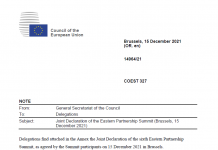The Committee of the Regions is the voice of regions and cities in the European Union.
350 members – regional and locally elected representatives from the 28 EU countries.
6 commissions covering competences in the following policy areas based on the EU Treaties:
- Employment, vocational training, economic and social cohesion, social policy, health.
- Education and culture.
- Environment, climate change, energy.
- Transport and trans-European networks.
- Civil protection and services of general interests.
6 plenary sessions a year.
More than 50 opinions a year on EU legislation.
More than 40 stakeholders consultations each year.
More than 300 events a year.
—————
KEY FACTS
Created in 1994, the European Committee of the Regions (CoR) is the European Unions assembly of regional and local representatives.
It is composed of 350 members – regional presidents, mayors or elected representatives of regions and cities – from the 28 EU countries.
Members must be democratically elected and/or hold a political mandate in their home country. Through the CoR, EU local and regional authorities can have a say on the development of EU laws that impact regions and cities.
But… why was the CoR created?
Since its establishment more than 20 years ago, the CoR has been working to bring citizens closer to the European Union.
- 70% of EU legislation has a direct regional and local impact
- EU citizens must be involved in the construction of the EU
- 50% of EU citizens believe their locally and regionally elected representatives are in a better position to represent them at the EU level
- regional and local elected authorities close to citizens should be able to communicate their views during the preparation of the EU legislation
How does the CoR bring EU closer to citizens?
- CoR members live and work in the regions or cities they come from and are therefore in touch with their electorates concerns
- They speak for their voters at the very heart of the EU decision-making and legislative process and also keep them abreast of EU developments, by hosting meetings and conferences of the CoR in their regions or cities
CoRs three fundamental principles
There are three main multilevel governance principles guiding the Committees work: subsidiarity, proximity and partnership.
- decisions in the EU must be taken as close as possible to the citizens
- the EU level must not take any action which could be carried out more efficiently by the national, regional or local authorities
- the Committee of the Regions has the right to bring an action before the Court of Justice of the European Union if this principle is breached (this right is enshrined in the Lisbon Treaty)
- all levels of governance must be close to the citizens
- transparency in the work of national, regional and local authorities is essential to ensure citizen participation in the democratic process
- the four levels of governance – EU, national, regional and local – cooperate closely to ensure good European governance;
- these four levels of governance are indispensable and must be involved throughout the decision‑making process.
The CoR and its areas of competence
- economic and social cohesion
- trans-European networks
- health
- education and culture
- employment
- social policy
- environment
- vocational training
- transport
- civil protection
- climate change
- energy









